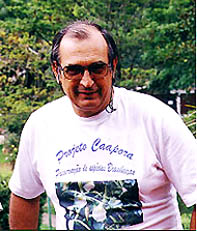

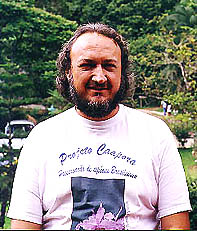

 |
 |
 |
| José Carlos Cavalin | Artur Norberto Heger |
There is a series of them. There may be Brazilian species still unknown. We try to focus our priority in new plants. If there is a plant which exists since thousands and thousands years and has been just discovered now, what is the reason? The habitat can be very restrict, can be inlaid in a mountain, in anywhere and, as it is small, it can disappear at any moment. This is a plant which needs to be urgently preserved even if there is myriad in the habitat.
 Can any alteration in its eco-system provoke its vanishing?
Can any alteration in its eco-system provoke its vanishing?
Exactly. Our principle is this, a new species must be reproduced immediately, sometimes people say it is not necessary because there is a great number at the habitat. No matter if there are thousands there. It is not interesting to root up thousands from the habitat and sell them, it encourages the wild hunt and facilitates the destruction of those new species. I never forget the possibility of an accident.
An accident or an exploitation of any natural resource?
I consider it as an accident too. To the nature, the construction of a dam is an accident too, a provoked accident, but still an accident.
Where and how is this project carrying on?
We work in São Paulo, in Cavalim's ranch where we reproduce the plants. As our project is not self-sufficient, we both work away and spend our week-ends working in it. 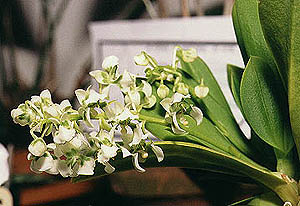 We receive the flasks, remove and place the plantlets at home, in our free times and during the week-end, we go to Cavalim's place where they stay. As we go just once a week, there is someone who takes care of them, just watering. If we have more free time to take care of the plants, they will grow faster but we should stop working and we can't do that.
We receive the flasks, remove and place the plantlets at home, in our free times and during the week-end, we go to Cavalim's place where they stay. As we go just once a week, there is someone who takes care of them, just watering. If we have more free time to take care of the plants, they will grow faster but we should stop working and we can't do that.
Our first idea was to start at the 15th World Orchid Conference which took place last year, in Rio de Janeiro. We did exactly it but we had already participated in some orchids shows in São Paulo.
When the plants reach a certain size, enough to be accepted, we should place something in the market. Our structure is about 400, 450m² of nursery and about 120.000 plants. A big part of them needs to be repotted but, if we repot all those plants, we will fill another nursery of 450m², which is under construction now. Selling small plants is interesting because, first of all, we get some money to the project and then, we'll retard our room's necessity.
And the final price?
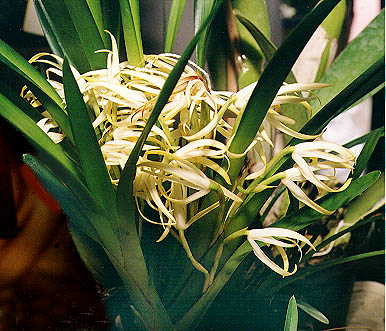 To analyzing the price of selling, we must consider that, since the flower is pollinated, we have at about 5 or 6 years of working until it reaches 2 or 3" including period of 6 months or a year of capsule. Because we don't have enough time, we removing the plants from the flasks when they are bigger. In the laboratory, the original flask of sowing suffer two initial prickings. The first one is done when the plantlets reach 1cm or less and when they are 1.5, 2cm long, another one and, in general, when they reach from 3 to 6cm, we remove them from the flask.
To analyzing the price of selling, we must consider that, since the flower is pollinated, we have at about 5 or 6 years of working until it reaches 2 or 3" including period of 6 months or a year of capsule. Because we don't have enough time, we removing the plants from the flasks when they are bigger. In the laboratory, the original flask of sowing suffer two initial prickings. The first one is done when the plantlets reach 1cm or less and when they are 1.5, 2cm long, another one and, in general, when they reach from 3 to 6cm, we remove them from the flask.
There is no community pot, we put the seedling direct on the individual pot. As our bigger problem is specialized people to work, we jump this stage. If we put the plants into community pots, let them developing for 6 months or a year, remove them, put them into the first individual pot which is a small plastic cup of coffee (to low the price), let there for more 6 months or a year, put them into another pot for 1 or 2 years until they reach 2 or 3" an then commercialize the plants, we'll have 3 proceeding of planting. If we only remove them from the flasks later, we jump this stage and have only 2 proceedings. Although this way of working delays the development of the plants, we avoid expenses with specialized workers and proceedings and for us, at this moment, it is the most important.
But with 120.000 plants, the project requires a big infra-structure to be run, doesn't it?
As I have already told, we are two persons and the caretaker who irrigates the plants and eventually, remove plants from the plastic cup, still in sphagnum moss and repot them. That's all, he is not able do anything more. 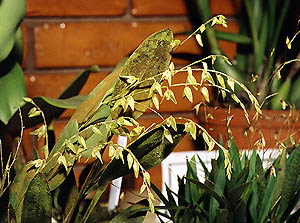 Recognize the orchid plant when it has 2 or 3cm, is hard, if we ask him to repot, he will throw away the orchids and set the weeds. If we are working with only one genus, Cattleya, they are very similar, but if we are working with Cattleya, Oncidium, Laelia, Pleurothallis, Maxillaria, they are very different and sometimes, we uproot the plantlet and there is a doubt if we are taking away the weeds or the orchids. We need specialized people with a great amount of knowledge but this kind of people are rare and when we find someone, it is very expensive to have him as a employee.
Recognize the orchid plant when it has 2 or 3cm, is hard, if we ask him to repot, he will throw away the orchids and set the weeds. If we are working with only one genus, Cattleya, they are very similar, but if we are working with Cattleya, Oncidium, Laelia, Pleurothallis, Maxillaria, they are very different and sometimes, we uproot the plantlet and there is a doubt if we are taking away the weeds or the orchids. We need specialized people with a great amount of knowledge but this kind of people are rare and when we find someone, it is very expensive to have him as a employee.
Which are the species you are working with?
We are selling a series of Brazilian Cattleyas, looking for the more uncommon like Cattleya kerrii, porphyroglossa, from Bahia, schofeldiana, Laelia fidelensis, more than 30 Oncidium , 3 or 4 species of Encyclia, Epidendrum, 3 or 4 species of Zygopetalum, 3 species of Promenaea, Sophronitis pygmaea, from Espírito Santo. We are producing Bifrenarias, plants which has not commercial appeals.
So, you have 7 years in the orchid market?
No, we have 7 years of production but we started to sell our plants since 3 years ago. 
The first plants are blooming now, we started to sell them too early and couldn't keep the best ones to see them blooming. If we'll take 20 plants between 200 to sell and keep the bigger to us and bring the others, we will sell plants with insignificant size, we can't do that.
We choose exactly the 10 or 15 which grown best to sell.
Nowadays, it happens to meet growers who tell us the plant he bought 1 or 2 years ago is blooming and ours are not. As we can't spend more time taking care of the plants, our development is slower than the most part of the nurseries since they don't suffer the excess of fertilization used by some producers. That is why is very common some people buy our plant and it doubles the size just in a while. It is due to the fact that it receives a better treatment than ours.
This is good in a certain way, the grower tells us his plant is better cultivated than the similar which stays with us.
Why don't you keep the bigger plants for the project?
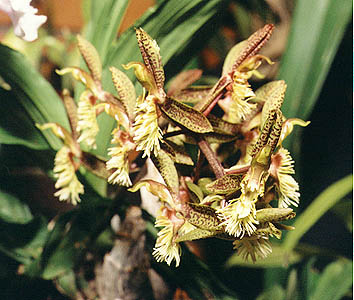 The question is: we should sell plants because, until now, we have just put money there. The moment we don't need to put more, it will be a great step. Even though we couldn't give up our job, we would reduce the time we spend with to those activities. Instead of working 4 days a week in order to get money to maintain the project, we could work 2 days a week to sustain our selves and take care of the plants the rest of the time. Even though they couldn't sustain us, we wouldn't sustain them any more. So we could work more and spend more time taking care of them and they would grow faster. However, it is a long term, we calculate in 2 or 3 years more to stop investing and 3 or 4 years to start having a return. The bigger plant, in blooming size, even though it is not blooming yet, is much more attractive. We have plant blooming in all seasons, we can't bring only those which are blooming, if our work is about preservation, we should bring interesting material. We can't tell the collector he can't buy the plant he wants in this show because it is not blooming.
The question is: we should sell plants because, until now, we have just put money there. The moment we don't need to put more, it will be a great step. Even though we couldn't give up our job, we would reduce the time we spend with to those activities. Instead of working 4 days a week in order to get money to maintain the project, we could work 2 days a week to sustain our selves and take care of the plants the rest of the time. Even though they couldn't sustain us, we wouldn't sustain them any more. So we could work more and spend more time taking care of them and they would grow faster. However, it is a long term, we calculate in 2 or 3 years more to stop investing and 3 or 4 years to start having a return. The bigger plant, in blooming size, even though it is not blooming yet, is much more attractive. We have plant blooming in all seasons, we can't bring only those which are blooming, if our work is about preservation, we should bring interesting material. We can't tell the collector he can't buy the plant he wants in this show because it is not blooming.
We imagine that a orchid grower who has already a certain number of plants, if he want a specific plant, he accepts to buy an small one although he knows he'll wait for long time before having it flowering but the non specialized buyer prefers a blooming plant or plant which buds are about to open, doesn't he?
Not always. We can feel a resistance in buying very small plants because they have already done it and lose the plant due to the excessive treatment it had received, as I have told before, the collector doesn't give the same treatment, it weakens and dies. As our plant doesn't receive this excess, it will survive with the new treatment received. Even if the person thinks that the plant can dye, he or she buys it because it is cheap. One year after, the same person meets us again in the same show and tells us that his plant grows well and is about to bloom. So, he buys 3 more plants and it goes on successively. In São Paulo, there is already a small group who obliges us to bring novelties for the shows. Normally , we bring at about 40 or 50 different species, sometimes, more than 70, we should satisfy the interested public.
In general, how many species, have you in cultivation?
We have already done more than 1.000 sowing and an optimism point of view, with 50% of success. We have already removed from the flasks 300 or 500 species or different sowings.
We have some primary hybrid because, first of all, some of them also occur in the nature, second, they are, in some way, attractive for the people. When we say that it is a result of two different species, that you are creating something new, the person is fascinated and buy it exactly because it is a hybrid, not a species. If, by chance, we have a reproduction that, although it is a hybrid, also occurs in the nature, in other words, a insect crosses different plants, the fascination is greater. Many peoples look for a primary hybrid that exists in the nature, even though obtained by artificial way. Those hybrids arose people's interest.
The micro-orchidarium you have for small plants, is a project of you?
This micro-orchidarium is a project in which we have been developing for small plants cultivation. Many people tell they don't like small plants because they will put it in the nursery or on the staging and they will neither see, nor cultivate them.
With the micro-orchidarium, the plant can be cultivated inside the house. This is an environment of artificial light, ventilation, humidity and temperature control and everything you need to cultivate this small plants. 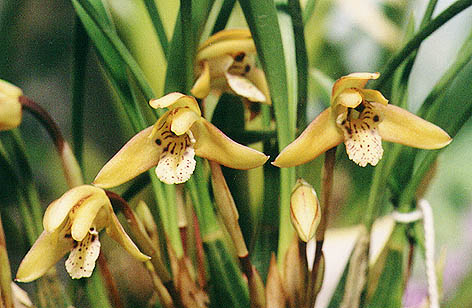 It becomes easier to cultivate seedlings, small plants or if you're interested in specific weather conditions of a certain place or area, you can reproduce this environment inside the micro-orchidarium. Even if you live at the seaside, you can cultivate plants from Andes, like Masdevallias. Or in the South, cultivate plants from Amazon. It exists abroad and I used my experiences with the cultivation inside glass to improve it, I studied how to do, I did some modifications, adaptations of material, looking for a solution to the problems I had. So I came to this shape, if it is the definitive, I don't know, perhaps I will improve it yet.
It becomes easier to cultivate seedlings, small plants or if you're interested in specific weather conditions of a certain place or area, you can reproduce this environment inside the micro-orchidarium. Even if you live at the seaside, you can cultivate plants from Andes, like Masdevallias. Or in the South, cultivate plants from Amazon. It exists abroad and I used my experiences with the cultivation inside glass to improve it, I studied how to do, I did some modifications, adaptations of material, looking for a solution to the problems I had. So I came to this shape, if it is the definitive, I don't know, perhaps I will improve it yet.
If someone is interested in having a micro-greenhouse , you can project and construct it?
No doubt about, if someone wants, we project and construct it.
| To write to the Caapora Project: Att. Artur Norberto Heger Rua Melo Matos, 42 Ipiranga 04280-040 São Paulo - SP Brazil Tel: (011) 273-3840 Fax: (011) 216-9838 |